Oana Ignat
NLP for Social Good: A Survey of Challenges, Opportunities, and Responsible Deployment
May 28, 2025



Abstract:Recent advancements in large language models (LLMs) have unlocked unprecedented possibilities across a range of applications. However, as a community, we believe that the field of Natural Language Processing (NLP) has a growing need to approach deployment with greater intentionality and responsibility. In alignment with the broader vision of AI for Social Good (Toma\v{s}ev et al., 2020), this paper examines the role of NLP in addressing pressing societal challenges. Through a cross-disciplinary analysis of social goals and emerging risks, we highlight promising research directions and outline challenges that must be addressed to ensure responsible and equitable progress in NLP4SG research.
SemEval-2025 Task 11: Bridging the Gap in Text-Based Emotion Detection
Mar 10, 2025Abstract:We present our shared task on text-based emotion detection, covering more than 30 languages from seven distinct language families. These languages are predominantly low-resource and spoken across various continents. The data instances are multi-labeled into six emotional classes, with additional datasets in 11 languages annotated for emotion intensity. Participants were asked to predict labels in three tracks: (a) emotion labels in monolingual settings, (b) emotion intensity scores, and (c) emotion labels in cross-lingual settings. The task attracted over 700 participants. We received final submissions from more than 200 teams and 93 system description papers. We report baseline results, as well as findings on the best-performing systems, the most common approaches, and the most effective methods across various tracks and languages. The datasets for this task are publicly available.
Multi-Agent Multimodal Models for Multicultural Text to Image Generation
Feb 21, 2025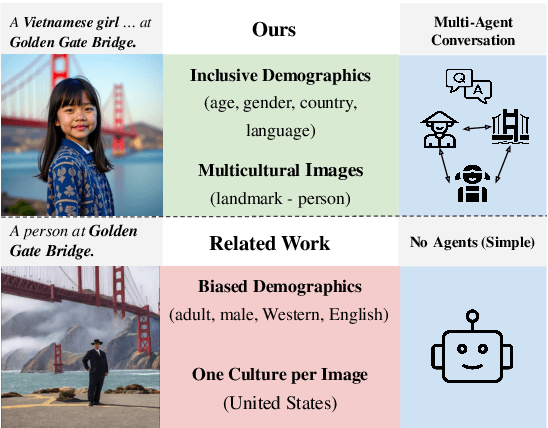
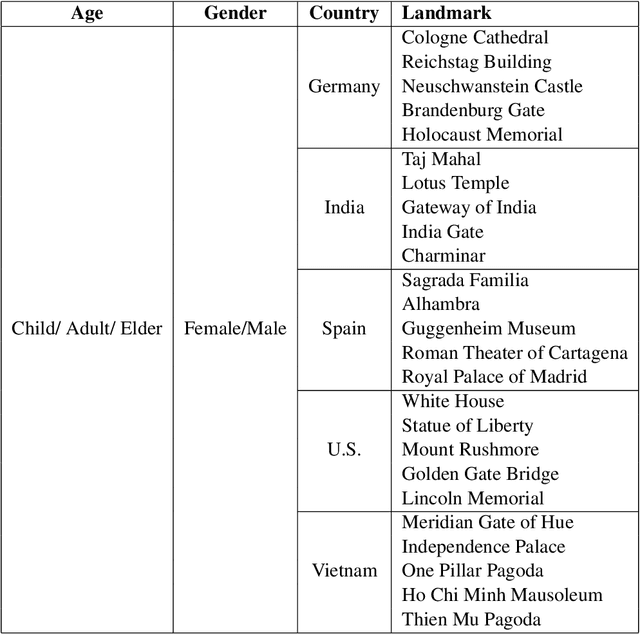
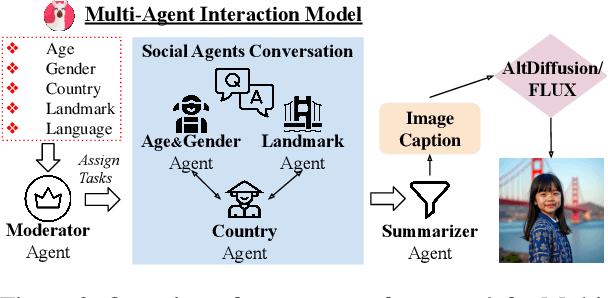
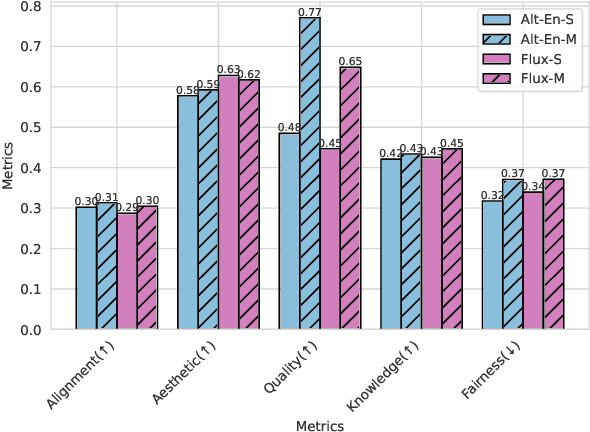
Abstract:Large Language Models (LLMs) demonstrate impressive performance across various multimodal tasks. However, their effectiveness in cross-cultural contexts remains limited due to the predominantly Western-centric nature of existing data and models. Meanwhile, multi-agent models have shown strong capabilities in solving complex tasks. In this paper, we evaluate the performance of LLMs in a multi-agent interaction setting for the novel task of multicultural image generation. Our key contributions are: (1) We introduce MosAIG, a Multi-Agent framework that enhances multicultural Image Generation by leveraging LLMs with distinct cultural personas; (2) We provide a dataset of 9,000 multicultural images spanning five countries, three age groups, two genders, 25 historical landmarks, and five languages; and (3) We demonstrate that multi-agent interactions outperform simple, no-agent models across multiple evaluation metrics, offering valuable insights for future research. Our dataset and models are available at https://github.com/OanaIgnat/MosAIG.
BRIGHTER: BRIdging the Gap in Human-Annotated Textual Emotion Recognition Datasets for 28 Languages
Feb 17, 2025Abstract:People worldwide use language in subtle and complex ways to express emotions. While emotion recognition -- an umbrella term for several NLP tasks -- significantly impacts different applications in NLP and other fields, most work in the area is focused on high-resource languages. Therefore, this has led to major disparities in research and proposed solutions, especially for low-resource languages that suffer from the lack of high-quality datasets. In this paper, we present BRIGHTER-- a collection of multilabeled emotion-annotated datasets in 28 different languages. BRIGHTER covers predominantly low-resource languages from Africa, Asia, Eastern Europe, and Latin America, with instances from various domains annotated by fluent speakers. We describe the data collection and annotation processes and the challenges of building these datasets. Then, we report different experimental results for monolingual and crosslingual multi-label emotion identification, as well as intensity-level emotion recognition. We investigate results with and without using LLMs and analyse the large variability in performance across languages and text domains. We show that BRIGHTER datasets are a step towards bridging the gap in text-based emotion recognition and discuss their impact and utility.
The Power of Many: Multi-Agent Multimodal Models for Cultural Image Captioning
Nov 18, 2024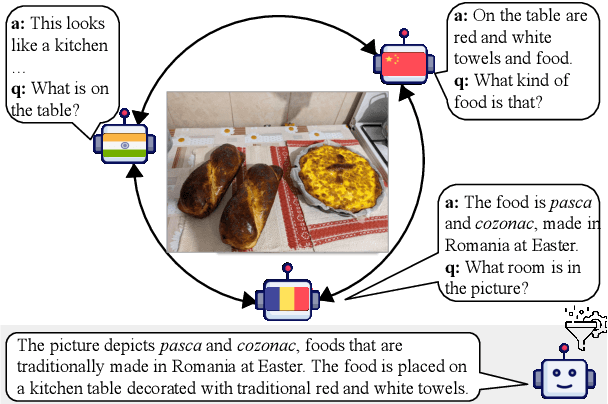
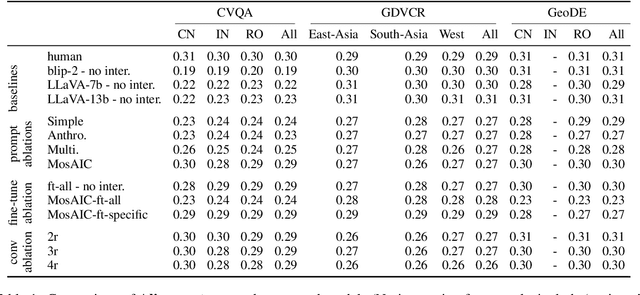
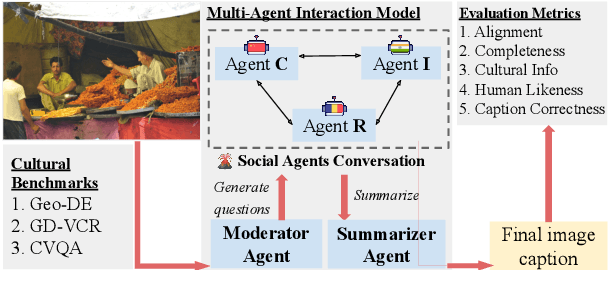
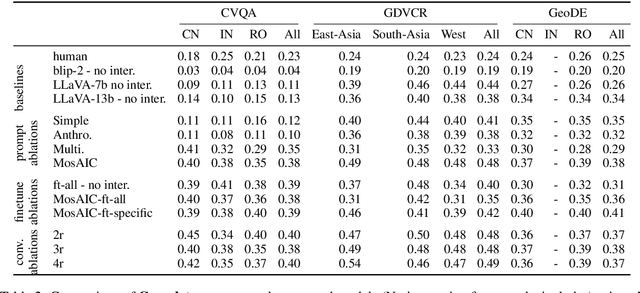
Abstract:Large Multimodal Models (LMMs) exhibit impressive performance across various multimodal tasks. However, their effectiveness in cross-cultural contexts remains limited due to the predominantly Western-centric nature of most data and models. Conversely, multi-agent models have shown significant capability in solving complex tasks. Our study evaluates the collective performance of LMMs in a multi-agent interaction setting for the novel task of cultural image captioning. Our contributions are as follows: (1) We introduce MosAIC, a Multi-Agent framework to enhance cross-cultural Image Captioning using LMMs with distinct cultural personas; (2) We provide a dataset of culturally enriched image captions in English for images from China, India, and Romania across three datasets: GeoDE, GD-VCR, CVQA; (3) We propose a culture-adaptable metric for evaluating cultural information within image captions; and (4) We show that the multi-agent interaction outperforms single-agent models across different metrics, and offer valuable insights for future research. Our dataset and models can be accessed at https://github.com/MichiganNLP/MosAIC.
Uplifting Lower-Income Data: Strategies for Socioeconomic Perspective Shifts in Vision-Language Models
Jul 02, 2024



Abstract:To address this issue, we formulate translated non-English, geographic, and socioeconomic integrated prompts and evaluate their impact on VL model performance for data from different countries and income groups. Our findings show that geographic and socioeconomic integrated prompts improve VL performance on lower-income data and favor the retrieval of topic appearances commonly found in data from low-income households. From our analyses, we identify and highlight contexts where these strategies yield the most improvements. Our model analysis code is publicly available at https://github.com/Anniejoan/Uplifting-Lower-income-data .
CVQA: Culturally-diverse Multilingual Visual Question Answering Benchmark
Jun 10, 2024



Abstract:Visual Question Answering (VQA) is an important task in multimodal AI, and it is often used to test the ability of vision-language models to understand and reason on knowledge present in both visual and textual data. However, most of the current VQA models use datasets that are primarily focused on English and a few major world languages, with images that are typically Western-centric. While recent efforts have tried to increase the number of languages covered on VQA datasets, they still lack diversity in low-resource languages. More importantly, although these datasets often extend their linguistic range via translation or some other approaches, they usually keep images the same, resulting in narrow cultural representation. To address these limitations, we construct CVQA, a new Culturally-diverse multilingual Visual Question Answering benchmark, designed to cover a rich set of languages and cultures, where we engage native speakers and cultural experts in the data collection process. As a result, CVQA includes culturally-driven images and questions from across 28 countries on four continents, covering 26 languages with 11 scripts, providing a total of 9k questions. We then benchmark several Multimodal Large Language Models (MLLMs) on CVQA, and show that the dataset is challenging for the current state-of-the-art models. This benchmark can serve as a probing evaluation suite for assessing the cultural capability and bias of multimodal models and hopefully encourage more research efforts toward increasing cultural awareness and linguistic diversity in this field.
MAiDE-up: Multilingual Deception Detection of GPT-generated Hotel Reviews
Apr 19, 2024Abstract:Deceptive reviews are becoming increasingly common, especially given the increase in performance and the prevalence of LLMs. While work to date has addressed the development of models to differentiate between truthful and deceptive human reviews, much less is known about the distinction between real reviews and AI-authored fake reviews. Moreover, most of the research so far has focused primarily on English, with very little work dedicated to other languages. In this paper, we compile and make publicly available the MAiDE-up dataset, consisting of 10,000 real and 10,000 AI-generated fake hotel reviews, balanced across ten languages. Using this dataset, we conduct extensive linguistic analyses to (1) compare the AI fake hotel reviews to real hotel reviews, and (2) identify the factors that influence the deception detection model performance. We explore the effectiveness of several models for deception detection in hotel reviews across three main dimensions: sentiment, location, and language. We find that these dimensions influence how well we can detect AI-generated fake reviews.
Cross-cultural Inspiration Detection and Analysis in Real and LLM-generated Social Media Data
Apr 19, 2024

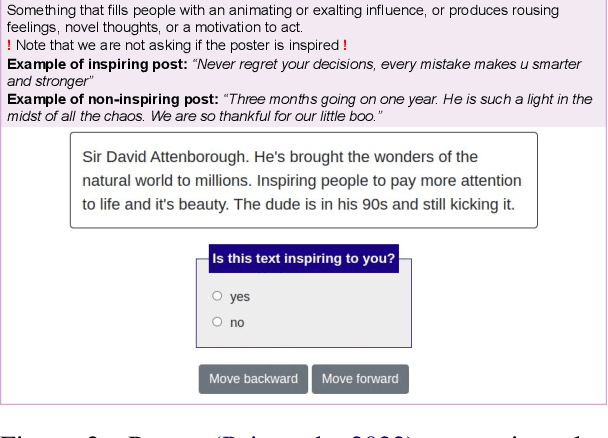

Abstract:Inspiration is linked to various positive outcomes, such as increased creativity, productivity, and happiness. Although inspiration has great potential, there has been limited effort toward identifying content that is inspiring, as opposed to just engaging or positive. Additionally, most research has concentrated on Western data, with little attention paid to other cultures. This work is the first to study cross-cultural inspiration through machine learning methods. We aim to identify and analyze real and AI-generated cross-cultural inspiring posts. To this end, we compile and make publicly available the InspAIred dataset, which consists of 2,000 real inspiring posts, 2,000 real non-inspiring posts, and 2,000 generated inspiring posts evenly distributed across India and the UK. The real posts are sourced from Reddit, while the generated posts are created using the GPT-4 model. Using this dataset, we conduct extensive computational linguistic analyses to (1) compare inspiring content across cultures, (2) compare AI-generated inspiring posts to real inspiring posts, and (3) determine if detection models can accurately distinguish between inspiring content across cultures and data sources.
Towards Algorithmic Fidelity: Mental Health Representation across Demographics in Synthetic vs. Human-generated Data
Mar 25, 2024



Abstract:Synthetic data generation has the potential to impact applications and domains with scarce data. However, before such data is used for sensitive tasks such as mental health, we need an understanding of how different demographics are represented in it. In our paper, we analyze the potential of producing synthetic data using GPT-3 by exploring the various stressors it attributes to different race and gender combinations, to provide insight for future researchers looking into using LLMs for data generation. Using GPT-3, we develop HEADROOM, a synthetic dataset of 3,120 posts about depression-triggering stressors, by controlling for race, gender, and time frame (before and after COVID-19). Using this dataset, we conduct semantic and lexical analyses to (1) identify the predominant stressors for each demographic group; and (2) compare our synthetic data to a human-generated dataset. We present the procedures to generate queries to develop depression data using GPT-3, and conduct analyzes to uncover the types of stressors it assigns to demographic groups, which could be used to test the limitations of LLMs for synthetic data generation for depression data. Our findings show that synthetic data mimics some of the human-generated data distribution for the predominant depression stressors across diverse demographics.
 Add to Chrome
Add to Chrome Add to Firefox
Add to Firefox Add to Edge
Add to Edge